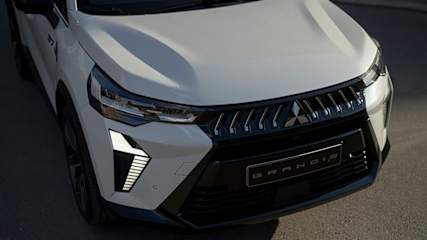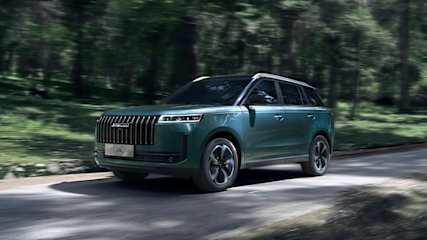1978 Mitsubishi Sigma Reviews
You'll find all our 1978 Mitsubishi Sigma reviews right here. 1978 Mitsubishi Sigma prices range from $730 for the Sigma Galant to $4,070 for the Sigma Scorpion.
Our reviews offer detailed analysis of the 's features, design, practicality, fuel consumption, engine and transmission, safety, ownership and what it's like to drive.
The most recent reviews sit up the top of the page, but if you're looking for an older model year or shopping for a used car, scroll down to find Mitsubishi dating back as far as 1977.
Or, if you just want to read the latest news about the Mitsubishi Sigma, you'll find it all here.
Mitsubishi Reviews and News
.jpg)
COVID hangover hitting used cars: The second-hand cars that are worth avoiding to ensure you’re getting the most value and are as safe as possible
Read the article
By Jack Quick · 22 Jul 2025
It’s been over five years now since COVID lockdowns started and in some way it feels like a lifetime ago.
For a lot of people buying new cars during this period, however, there were long wait times. COVID lockdowns were a key reason for this, but another major reason for delays was the global shortage of semiconductors.
 copy.jpg)
The rise of the anti-EVs: Mitsubishi, Nissan, Toyota, Kia and more fuelling mega ladder-frame SUV and ute revival through models like the 2026 Pajero, Y63 Patrol, Tasman and HiLux
Read the article
By Andrew Chesterton · 19 Jul 2025
The long-promised electric revolution appears to have been pushed back, at least for a couple more years, with established brands and Chinese newcomers alike doubling down on big ICE-powered SUVs and utes – some without any electrification at all.
.jpg)
Meet Mitsubishi's new family SUV: 2026 Mitsubishi Destinator revealed as new seven seat rival to the Chery Tiggo 8, Honda CR-V and Nissan X-Trail
Read the article
By Tom White · 18 Jul 2025
Mitsubishi reveals a sharply-styled new three-row SUV - but is it heading to Oz?
.jpg)
Won't chase Chinese brands to the bottom: Mitsubishi said competing on price won't work and buyers still see value in Honda, Subaru and Mazda as Japanese favourites feel the squeeze from new top Chinese players GWM, BYD and MG
Read the article
By Tom White · 15 Jul 2025
Mitsubishi warns it can't chase Chinese brands on price, and there are other factors buyers should consider.
.jpg)
'We will survive!': Mitsubishi is 'not anti-Chinese' but warns there will be a 'correction' in the oversupplied Australian new car market as some new brands become dependable local favourites
Read the article
By Tom White · 12 Jul 2025
Mitsubishi warns there's a big market correction coming, and automakers have to act to survive.
.jpg)
Nissan scores lifeline from unexpected brand: Foxconn throws Japanese giant an opportunity to save its historic factory
Read the article
By Tom White · 11 Jul 2025
Taiwanese cars built in Japan? Foxconn eyes off historic Nissan factory as potential joint-venture.

Mitsubishi Outlander 2026 review: Australian first drive
Read the article
By Tom White · 10 Jul 2025
Mitsubishi Australia brings a local flavour to its widely appealing Outlander mid-size SUV.
.jpg)
'You can give as many sticks as you like, but we need carrots': Mitsubishi lashes out against tough new emissions standards as it stands by new combustion versions of 2026 Outlander, Triton, and ASX - relying on PHEVs as the 'considered' option
Read the article
By Tom White · 10 Jul 2025
Mitsubishi's CEO, Shaun Westcott, explained the effect he thinks Australia’s tough new emissions laws will have on the new car market, and why Mitsubishi will continue to stick with its PHEV-heavy strategy.Westcott said there are still significant hurdles to overcome for electric cars despite the New Vehicle Efficiency Standard (NVES) coming into effect.“Just penalising us is not going to deliver the outcomes we need. The original thinking was that if you penalised us, we’d bring more EVs to the market.”“There’s no shortage of choice, what we lack is positive initiatives. You can give us as many sticks as you like, we need some carrots.”“The bigger challenge with adoption is that we need to have a government which considers the peculiarities of the Australian market. We’re not Norway. We’re not a small country. We don’t have cities that are 40 kilometres apart.”He said even with advancements in battery technology, which may result in vehicles able to travel between Sydney and Melbourne on a single charge, having infrastructure sufficient for the cities was an ongoing issue.“As we sit here today, Adelaide has 52 public fast chargers. 52 for a city of one and a half million people!”Westcott added if Mitsubishi’s number crunching was reflective of the wider market, price hikes could be headed for most brands as they try to keep up with the regulations which have effectively moved Australia from the emissions environment of the 1980s to the strict nature of Euro 6 overnight.He said despite the abundance of options, even at lower price points, Australian consumers still preferred combustion engines overall, which will cause a problem for many manufacturers, and soon.“I think the reality we’re looking at today is a lot of brands have dialled back their EV ambitions because they’ve realised that just bringing the cars to the market, you can fill your showroom with EVs but if nobody buys them you’d have to discount those cars to a point where they will be below the cost of production and that’s happening already just to get people to take them," said Westcott.“OEMs realise that to stay alive you have to sell cars - if Australians aren’t buying the EVs then we have to bring combustion and all the other powertrains to market and that will continue to happen despite the penalties because if the demand isn’t there, you haven’t got a business. It’s simple economics.“Every brand has to cover the cost of those penalties to survive and if customers are only buying single digit (percentages) of EVs - everyone is going to be copping penalties,” he said.Westcott still backs PHEVs in the short term.“We believe this is the correct transition technology. Our customers use their car in pure EV mode 83 per cent of the time," said Westcott.“ our customers have reduced emissions by 83 per cent right here, right now, today, with zero investment in infrastructure.“And if I wanted to do a trip to Melbourne, or Sydney, or across the Nullabor to Perth. It doesn’t matter, the car can do it.”Westcott was also blunt about how he sees the choice to remove the fringe benefits tax exemption, which (along with the original EV exemption) caused a spike in interest for PHEV models, was a political error when it comes to emissions reduction.“Stopping the FBT exemption on PHEVs was a mistake - Look what it did! PHEV Outlander was 20 - 25 per cent of the mix, it worked. It comes back to the carrots and the sticks. If we had a few more carrots it works. Lets do it.”It’s worth noting Mitsubishi has everything to gain by such changes. It currently doesn’t field a fully electric vehicle, with plans to bring in the eK X electric city car shelved after a brief local evaluation program.Plus, some manufacturers with diverse offerings in their line-ups have spoken out in favour of the NVES, as models they currently import from Europe or China already comply with even more stringent regimes in their respective home markets.Chinese manufacturers, meanwhile, are squeezing Mitsubishi on its plug-in hybrid home turf with unprecedented price-tags attached to incoming versions of the Chery Tiggo 7 and Tiggo 8 PHEV competing on price with combustion Outlanders and undercutting Mitsubishi’s Outlander PHEV by a significant margin.Mitsubishi isn’t alone though. Japanese manufacturers seem to be in particular trouble, as they struggle to adjust to a regulatory environment much more hostile to their historically popular nameplates. Subaru, Isuzu, Mazda, and to some extent, even Toyota will have work to do in the coming years if they want to avoid painful fines under the new laws.

Mitsubishi brings back another big name: 2026 Mitsubishi Grandis revealed in Europe now as an SUV with hybrid power, though will this Renault Symbioz twin ever come to Australia?
Read the article
By Jack Quick · 09 Jul 2025
Mitsubishi is currently on a hot streak of reviving classic nameplates for its line-up in Europe.

China's Mitsubishi ASX and Kia Seltos rival has just been confirmed for the UK giving us a look at the 2026 Jaecoo J5 SUV ahead of its Aussie arrival
Read the article
By Laura Berry · 07 Jul 2025
Chinese carmaker Jaecoo has confirmed its J5 small SUV will go on sale in the United Kingdom paving the way for the small SUV’s entrance to Australia.The J5 looks very much like the J7 mid-sized SUV only smaller, measuring 4.3m in length, and rivalling the Kia Seltos, Mitsubishi ASX and Mazda CX-30.The J5 will debut in the UK with a 1.6-litre turbo-petrol engine and seven-speed dual-clutch automatic transmission.In the UK the five-seater SUV will go on sale in two trim levels: the Pure and the Luxury.Coming standard on the Pure will be a six-speaker stereo, power adjustable front seats and Apple CarPlay and Android Auto. Stepping up to the Luxury will add a panoramic sunroof, heated and ventilated front seats and wireless phone charging.Jaecoo is the luxury-focussed sub-brand of Chery and currently has two SUVs on sale in Australia - the mid-sized J7 and the J8 large SUV.The J5 will definitely be making its way to Australia as well, but as to when this will happen is unknown. Recently Jaecoo Australia’s Chief Commercial Officer, Roy Munoz, confirmed the J5 is headed to Australia to CarsGuide, but didn't reveal timing.Pricing for the J5 hasn't been announced in the UK nor Australia, but buyers can be certain it will be less than the J7 and the J8.As a guide the J7 starts at $34,990 drive-away and the entry grade J8 is $49,990.Jaecoo doesn't have any electric vehicles on sale currently in Australia with both the J7 and J8 using petrol engines, but the J7 is also available with plug-in hybrid power.Jaecoo is a very new brand to Australia having only arrived in May this year and follows its parent company Chery, which launched its vehicles here in 2023.Currently Chery has several models on sale in Australia including the petrol powered C5 small SUV and its E5 electric twin, while there’s three hybrid SUVs also available: the small Tiggo 4, the mid-sized Tiggo 7 and the large Tiggo 8.




